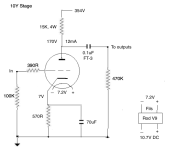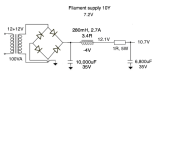I looked closely at the good old DN2540 vs. the newer AOT1N60. I think the DN2540 is a much better choice for a CCS or Mu stage: https://www.diyaudio.com/community/...stat-headphone-amp-osdeha.407679/post-7716964
I've been trying plate chokes. I have an amorphous NP one which is 15mA and 136H. Quite small. It sounds very nice and clear, but there's some hum at the moment plus the treble appears to have some resonance. I'm thinking of getting a pair of LL1668/25mA which by reports should be free of such issues.
In the meantime I'm trying this with a Hammond 126B pair I have - building it ATM.
Question: should the resistor go above the choke to the B+ or below the choke to the anode? Does it matter?
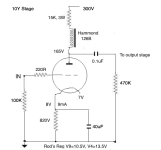
In the meantime I'm trying this with a Hammond 126B pair I have - building it ATM.
Question: should the resistor go above the choke to the B+ or below the choke to the anode? Does it matter?

I don't see how the resistor above or below the choke would make a difference. The tube anode just sees ther series impedance of resistor+choke.
But: what's the purpose of the resistor?
But: what's the purpose of the resistor?
The purpose of the resistor is to add to the effectiveness of the choke. The 126B has an inductance of 44H and we really need 100H.
I don't know how big the resistor needs to be - smaller would allow more current and a higher anode voltage. It's the first time I've tried this arrangement.
I don't know how big the resistor needs to be - smaller would allow more current and a higher anode voltage. It's the first time I've tried this arrangement.
Adding a resistor will not add to the inductance. You could use two 126B in series, or a different choke with higher inductance. Or take another look at CCS loads, which are insensitive to hum pickup or oscillation at audio frequencies...
I actually preferred a sand CCS in my KT66 amp over a plate choke: https://www.diyaudio.com/community/...kt66-and-some-other-parts.310209/post-5300131
I actually preferred a sand CCS in my KT66 amp over a plate choke: https://www.diyaudio.com/community/...kt66-and-some-other-parts.310209/post-5300131
I listened to the 126B choke + 15K resistor combination, and for whatever reason it didn't sound that great. The Amorphous NP choke was much nicer sounding. I'm getting a loud hum. Will have to track it down. It's the same with both chokes. So looks like it's back to the NP choke and fix the hum.
The filament (raw) supply shows a connection to GND, while it should be floating. Is that just a mistake in the drawing?
Apologies - of course the filament supply is floating, it always is. I should not have put the ground symbol on it. I'll correct that.
When I write 12+12V that's a dual output toroid, so 2x 12V, one per tube. I should make that clearer. I use toroids these days because I had problems with EI types buzzing with continuous filament supplies. Toroids don't seem to buzz.
When I write 12+12V that's a dual output toroid, so 2x 12V, one per tube. I should make that clearer. I use toroids these days because I had problems with EI types buzzing with continuous filament supplies. Toroids don't seem to buzz.
Re-drawn filament supplies. Rod would probably recommend a better EI transformer for a "proper" supply, but I had problems with buzzing with some I had off ebay even when they had more than enough VA. I have to confess to putting them back on ebay myself.......
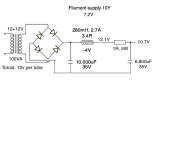
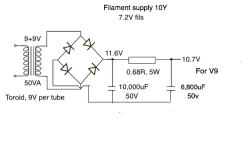
I've been reflecting on coupling caps. For a 5K Rp tube like 10Y it would need to go into a stage with 47K input impedance or greater, so looks like 0.4uF or 0.5uF minimum. I personally find FT-3 or FT-2 the clearest, cleanest coupling caps so that means a few 0.1 in parallel which takes space. As an alternative I've tried KBG-MN PIO film caps which have a bit more body but a bit less detail and airiness. Obviously others will have different choices including boutique caps.


I've been reflecting on coupling caps. For a 5K Rp tube like 10Y it would need to go into a stage with 47K input impedance or greater, so looks like 0.4uF or 0.5uF minimum. I personally find FT-3 or FT-2 the clearest, cleanest coupling caps so that means a few 0.1 in parallel which takes space. As an alternative I've tried KBG-MN PIO film caps which have a bit more body but a bit less detail and airiness. Obviously others will have different choices including boutique caps.
Bela, you show a 2H choke on your PSU (first smoothing choke) with that voltage and 70mA draw, would 2H not be lower than the critical inductance? I know the calculation for critical inductance as 1.2*v/draw (mA) for 50Hz.
This was at home in the drawer. 🙂
Kidding aside, the current is practically constant (due to the "gyrator" loading stages), so dynamic behaviour -in this case- is not so important.
The important thing is the hum ... apart from that the gyrator PSRR is high/er/.
The overall PSRR of the preamp is more than 40dB.
If the B+ has few-few ten mV hum, this on the output is unnoticeable.
Kidding aside, the current is practically constant (due to the "gyrator" loading stages), so dynamic behaviour -in this case- is not so important.
The important thing is the hum ... apart from that the gyrator PSRR is high/er/.
The overall PSRR of the preamp is more than 40dB.
If the B+ has few-few ten mV hum, this on the output is unnoticeable.
I was wondering if there was a particular reason. I do understand the lower requirements on the PSU when using the gyrator (which I am also using). I have lately been interested learning about PSU chokes (in general), both LC and cLCLC configurations and their use is constant draw and varying draw circuits.
- Home
- Amplifiers
- Tubes / Valves
- 801a tube preamp
